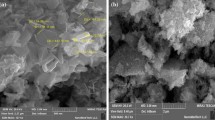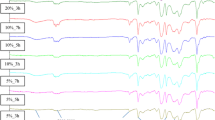Abstract
This paper investigates the influence of magnetic field-assisted filler alignment technology on the morphology and the thermal conductivity of magnetite-filled epoxy composites. A magnetic field was applied during the solidification of the composite in order to change the position of the filler and its distribution in the polymer matrix. It is shown that the applied procedure leads to the filler being oriented along the direction of the magnetic field, and as a result, the thermal conductivity is improved by up to 120 % compared to a composite with randomly oriented filler obtained without the assistance of a magnetic field. This positive effect is caused by the appearance of conductive paths at a much lower content of the filler when the composite solidification is assisted by a magnetic field, relative to an equivalent isotropic sample. These morphological changes were confirmed by microscopic and X-ray microtomography imaging. The temperature dependences of thermal conductivity were also investigated over a broad temperature range for a magnetite-filled epoxy composite sample and compared to the bulk magnetite reference, showing that thermal behaviour of the magnetite-filled composite is stable, which is a promising result when considering the future application of the technology.






Similar content being viewed by others
References
Filippakou MP, Karagiannopoulos C, Agoris DP, Bourkas PD (2001) Electrical contact overheating under short-circuit currents. Electr Power Syst Res 57:141–147
Wong CP, Bollampally RS (1999) Comparative study of thermally conductive fillers for use in liquid encapsulants for electronic packaging. IEEE Trans Adv Packag 22:54–59
Garett KW, Rosenberg HM (1974) The thermal conductivity of epoxy-resin/powder composite materials. J Phys D Appl Phys 7:1247–1258
Medina-Esquivel R. A. et al. Thermal characterization of composites made up of magnetically aligned carbonyl iron particles in a polyester resin matrix. J Appl Phys 2012;111:054906
Scholz M-S et al (2013) Ultrasonic assembly of anisotropic short fibre reinforced composites. Ultrasonics 54:1015–1019
Kim GH (2004) Electroactive polymer composites as a tactile sensor for biomedical applications. Macromol Res 12:564–572
Kim GH, Shkel YM (2004) Polymeric composites tailored by electric field. J Mater Res 19:1164–1174
Correa-Duarte MA, Grzelczak M et al (2005) Alignment of carbon nanotubes under low magnetic fields through attachment of magnetic nanoparticles. J Phys Chem B 109(41):19060–19063
Camponeschi E, Vance R et al (2007) Properties of carbon nanotube-polymer composites aligned in a magnetic field. Carbon 45(10):2037–2046
Kimura T, Ago H et al (2002) Polymer composites of carbon nanotubes aligned by a magnetic field. Adv Mater 14(19):1380–1383
Abdalla M, Dean D, Theodore M, Fielding J, Nyairo E, Price G (2010) Magnetically processed carbon nanotube/epoxy nanocomposites: morphology, thermal, and mechanical properties. Polymer 51:1614–1620
Kim IT, Tannenbaum A, Tannenbaum R (2011) Anisotropic conductivity of magnetic carbon nanotubes embedded in epoxy matrices. Carbon 49:54–61
Zhao W, Wang H, Tang H, Chen G (2006) Facile preparation of epoxy-based composite with oriented graphite nanosheets. Polymer 47:8401–8405
Yan H, Tang Y, Long W, Li Y (2014) Enhanced thermal conductivity in polymer composites with aligned graphene nanosheets. J Mater Sci 49:5256–5264. doi:10.1007/s10853-014-8198-z
Lin Z, Liu Y, Raghavan S, Moon K (2013) Magnetic alignment of hexagonal boron nitride platelets in polymer matrix: toward high performance anisotropic polymer composites for electronic encapsulation. ACS Appl Mater Interfaces 5:7633–7640
Erb RM, Libanori R et al (2012) Composites reinforced in three dimensions by using low magnetic fields. Science 335(6065):199–204
Libanori R, Erb RM et al (2013) Mechanics of platelet-reinforced composites assembled using mechanical and magnetic stimuli. ACS Appl Mater Interfaces 5(21):10794–10805
Erb RM, Sander JS et al (2013) Self-shaping composites with programmable bioinspired microstructures. Nature Commun 4:1712
Porter MM, Yeh M et al (2012) Magnetic freeze casting inspired by nature. Mater Sci Eng A 556:741–750
Sommer MR, Erb RM et al (2012) Injectable Materials with Magnetically Controlled Anisotropic Porosity. ACS Appl Mater Interfaces 4(10):5086–5091
Weidenfeller B, Hofer M, Schilling F (2002) Thermal and electrical properties of magnetite filled polymers. Compos A 33:1041–1053
Physical Property Measurement System, Thermal Transport Option User Manual, Part Number 1684-100B, Quantum Design Corp, San Diego, USA.
Maldonado O (1992) Pulse method for simultaneous measurement of electric thermopower and heat conductivity at low temperatures. Cryogenics 32(10):908–912
Tritt T (2004) Thermal conductivity: theory, properties, and applications. Kluwer Academic/Plenum Publishers, New York
Cheng SC, Vachon RI (1970) A technique for predicting the thermal conductivity of suspensions, emulsions and porous materials. Int J Heat Mass Transfer 13:537–546
Droval G, Feller J-F, Salagnac P, Glouannec P (2006) Thermal conductivity enhancement of electrically insulating syndiotactic poly(styrene) matrix for diphasic conductive polymer composites. Polym Adv Technol 17:732–745
Agari Y, Ueda A, Nagai S (1993) Thermal conductivity of a polymer composite. J Appl Polym Sci 49:1625–1634
Agari Y, Tanaka M, Nagai S, Uno T (1987) Thermal conductivity of a polymer composite filled with mixtures of particles. J Appl Polym Sci 34:1429–1437
Schwenk H et al (2000) Charge ordering and elastic constants in {Fe_{3-x}Zn_{x}O_{4}}. Eur Phys J B 13:491–494
Author information
Authors and Affiliations
Corresponding author
Rights and permissions
About this article
Cite this article
Gaska, K., Kmita, G., Rybak, A. et al. Magnetic-aligned, magnetite-filled epoxy composites with enhanced thermal conductivity. J Mater Sci 50, 2510–2516 (2015). https://doi.org/10.1007/s10853-014-8809-8
Received:
Accepted:
Published:
Issue Date:
DOI: https://doi.org/10.1007/s10853-014-8809-8




